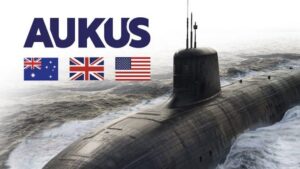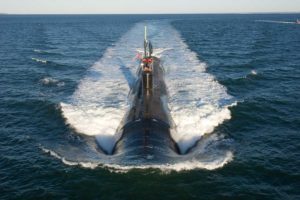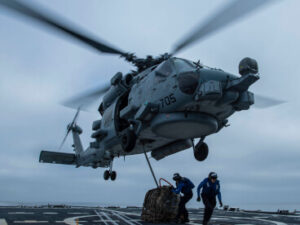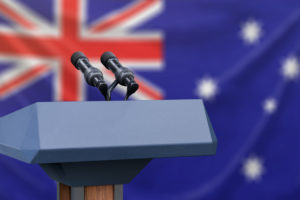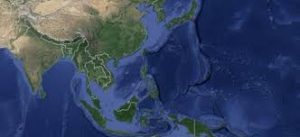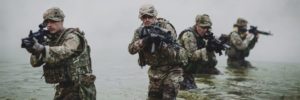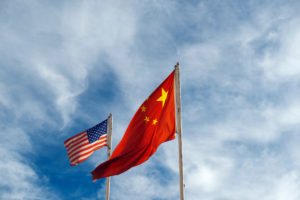Introduction
Special operations (SO) have emerged as an important area of quiet collaboration since the trilateral AUKUS pact was announced in September 2021. Special operations forces (SOF) were central to the War on Terror, with Australian, British, and American SOF cooperating closely in Iraq and Afghanistan. But neutralizing non-state armed groups differs dramatically from great-power competition (GPC) against adversaries like Russia and China. As a result, SOF in all three nations have been evolving toward new capabilities for GPC. AUKUS offers opportunities to accelerate this adaptation, both for SOF and SOF-adjacent assets such as amphibious and airborne forces and security force assistance troops. This essay explores the evolution of Australian, British, and American SO from the War on Terror toward GPC and examines how AUKUS can help reorient SOF to the new environment.
Special Operations in the War on Terror
During the War on Terror, SOF performed three main missions. The first—seen during the initial invasion of Afghanistan in 2001, the “awakening” in Iraq in 2007, and the campaign against the Islamic State in 2015-19—was what American and British doctrine calls unconventional warfare (UW) and Australians call special warfare (SW). This employed SOF teams to organize, train, advise, and assist guerrillas in enemy-controlled terrain. UW/SW requires independent operators able to function with minimal support, individual initiative and resilience, deep area knowledge, and the cultural and language skills to survive alone, for lengthy periods, in enemy-controlled terrain. It enabled several successes in the War on Terror but was not the day-to-day task for most SOF.
The second mission was security force assistance (SFA). Throughout Africa, the Middle East, and Southeast Asia, SOF advisors helped build partner forces’ capacity for counterterrorism or stabilization. SFA mostly involved training conventional forces in friendly-controlled or contested terrain, with access to extensive support; it gradually became seen as SOF-adjacent rather than a core SOF task. Australia, with a long tradition of SFA, selected training teams from a mix of conventional and SOF organizations, deploying them to Iraq, Afghanistan, and the Philippines. British and U.S. forces created Security Force Assistance Brigades (SFABs), specialized units that gradually took over most SFA, freeing SOF for higher-end tasks.
The most demanding task was direct action (DA)—killing or capturing terrorists. DA employed specialized assault teams supported by an immense intelligence, surveillance, targeting, aviation, and logistics infrastructure. It involved short-duration but intense assaults supported by drones and combat aircraft. Over time, DA evolved into an integrated cycle, servicing target lists at industrial scale around the clock. Individual combat skills were critical in this context, initiative and cultural/language skills less so; the individual operator was, in effect, a highly trained cog in a large, well-oiled machine. DA was extremely dangerous and technically demanding. Understandably, given its difficulty, high risk, and strategic prominence, DA came to absorb the bulk of effort, resourcing, and attention from SOF.
The pressure to excel at these three mission sets—particularly DA—drove SOF adaptation during the first two decades of the 21st century. SOF became fungible: an Australian Special Air Service Regiment (SASR) troop or Commando platoon, for example, would receive identical tasking to—and thus needed to be functionally interchangeable with—a U.S. Navy SEAL platoon or British Special Air Service (SAS) troop. National and service-specific characteristics that differentiated SOF units at the start of the war were flattened out by the need to perform similar, repetitive missions in the same environment. That environment—with exceptions—was land-based, austere, located in the developing world, against adversaries who lacked air and naval forces, long-range fires, electronic warfare, armoured vehicles, or similar high-end capabilities.
SO for Great-Power Competition
Even before large-scale combat operations in the War on Terror began to wind down with the territorial defeat of the Islamic State’s “caliphate” in 2019, SOF in the AUKUS nations (and other allies) had started reorienting to the emerging era of GPC. Initial adaptations focused on updating SOF organization, tactics, doctrine, and technologies for a wider range of environments, more capable adversaries, and new missions. SOF leaders recognised that counterterrorism was not going away; rather, GPC would coexist alongside UW/SW, SFA, DA, and enduring tasks such as hostage rescue and countering weapons of mass destruction.
It soon became clear, however, that the fundamental adaptation needed was a mindset shift. During the War on Terror, SOF had often been tactically offensive but strategically defensive. They dominated the battlefield through offensive maneuver, rarely encountering adversaries able to match them in combat power. But strategically, the purpose of such operations was defensive, a holding action to allow other means—diplomatic, political, and economic—to address the underlying issues driving terrorism. Despite (or perhaps because of) SOF’s tactical excellence in suppressing terrorism, strategic efforts to address its causes lagged and ultimately failed—fostering today’s “forever wars” of persistent, ubiquitous low-level terrorist threat.
By contrast, in GPC, tactical actions are mostly defensive—shoring up resilience to foreign interference, supporting whole-of-nation defense, assisting government-sponsored resistance movements to deter invasion, cyber-defence and counterinfluence. But at the strategic level, Western posture is often offensive in effect if not intent, as seen in NATO’s encroachment on Russia’s “red lines” in Moscow’s near abroad, or freedom-of-navigation operations in Beijing’s claimed sphere of influence in the South China Sea and Taiwan Strait. Thus, SOF frequently find themselves conducting long-range, long-duration, dispersed, stealthy missions, in or near the territory of adversaries able to generate local tactical overmatch, in a reversal of the last 20 years.
Since adversaries in GPC are nuclear-armed great powers with capable conventional military forces, most competition takes place in the “gray zone” (in British parlance, sub-threshold), below the level of overt armed conflict but beyond normal peacetime statecraft. “Cross-domain coercion” is the norm, across multiple simultaneous categories of competition. SOF are the force of choice for gray zone tasks, but they require new capabilities and, most importantly, need to shed the War on Terror mindset; GPC involves not only countering threats but also becoming the threat, conducting offensive or disruptive gray zone activities against high-end adversaries.
In this setting, DA is less frequent, while SFA is increasingly important, and variations on UW/SW, including support to resistance (STR), increasingly rely on remote-access technologies to support partners at a distance using electronic means. Against great-power adversaries with advanced cyberwarfare, electronic attack, and signals intelligence capabilities, such approaches require updating. Likewise, SOF reliance on space-based systems such as GPS, satellite communications, and overhead sensing is problematic against adversaries whose space-warfare and counterspace capabilities match or exceed our own.
Old-school approaches (HF Morse Code communications, direction-finding via LORAN-C, or celestial navigation) are part of the solution, but new technologies—including LiDAR targeting, magnetometer-based navigation, tropospheric scatter communications, or quantum entanglement for encryption—are also critical. SOF today are in an adaptation race against adversaries whose technology acquisition ecosystems are much more agile than our own. Likewise, when adversaries have hypersonic missiles, loitering munitions, and capable air forces, SOF commanders who “never had to look up because the U.S. always maintained air superiority” now need agile air defense, counter-drone, counter-surveillance, and cyberdefense tools to survive.
Implications of AUKUS
Against this background, AUKUS offers opportunities for accelerated adaptation and economies of scale for SOF and SOF-adjacent forces. Maritime and littoral SOF are at a premium in GPC, particularly in the Indo-Pacific theater, with its vast oceanic distances and complex coastal hydrography. AUKUS-driven partnership offers SOF innovation in autonomous systems, underwater and surface technologies, maritime raiding, long-range reconnaissance, and non-standard maritime and aviation operations. In each category, one or more of the AUKUS partners is better-resourced or further along than the others, so that pooling research efforts could accelerate adaptation. Such cooperation could also help AUKUS partners achieve the goal of being “interchangeable” rather than merely interoperable, creating the opportunity to “operate seamlessly together, at speed”—a traditional SOF capability.
The U.S. SOFWERX and Australia’s equivalent organization offer lessons that could be hugely useful for the UK’s recently-created Defence BattleLab. Science and technology collaboration among AUKUS partners is longstanding, but increased research funding—and the associated industrial innovation policies and critical technology mapping—offers opportunities for joint specialized research on SO.
Doctrinally, U.S. and European partners have been developing a Resistance Operating Concept and manuals for GPC, refining them over multiple training cycles, with SOF training alongside territorial defense forces for STR in enemy-occupied terrain. While the U.S. does not officially have a presence in Ukraine, the war there has offered a dose of reality on the feasibility of STR techniques, enabling rapid improvement. Although Australia and the UK do not formally include STR as a core SOF task, both have a long tradition of such operations, making joint STR doctrine feasible under AUKUS. Indo-Pacific partners have conducted STR workshops with U.S. and European SOF, and adapting approaches from the European theater to local conditions would likewise make sense for Australia.
SOF-adjacent capabilities also offer scope innovation. The UK’s Future Commando Force (FCF) reorganized and re-equipped Royal Marines Commandos for the more threatening, dispersed, and connected environment of GPC, resulting in agile SO-capable commando units and offering lessons for the United States Marine Corps (USMC) and Australian Amphibious Force. Indeed, Australia’s specialized amphibious unit, the 2nd Battalion, Royal Australian Regiment (2RAR), with its associated supporting assets, looks and operates very similarly to an FCF-adapted Royal Marines Commando. 45 Commando Royal Marines, an FCF-adapted unit, performed strikingly well in exercises with the USMC in 2021, suggesting that cross-pollination among AUKUS partners could offer significant benefits for tactical innovation.
Notably, the Royal Navy possesses insufficient sealift to deploy all available Royal Marines Commandos, whereas Australia currently fields one battalion-sized amphibious unit but has two landing helicopter dock (LHD) amphibious assault ships, each capable of embarking a battalion group. There is an obvious opportunity here for Royal Marines Commandos to operate with 2RAR and the Royal Australian Navy’s amphibious group—perhaps similarly to the USMC’s rotational deployments to the northern Australian city of Darwin.
In terms of airborne capability, both the UK and U.S. maintain rapidly deployable parachute and helicopter-delivered forces—two divisions in the U.S. and one brigade in the UK; Australia retired its non-SOF airborne battlegroup more than a decade ago, with only SASR and Commando units currently practicing airborne insertion. The feasibility of opposed parachute assault in modern warfare is debated, and the opening days of the Ukraine war offered new material for that debate. Still, airborne assets can rapidly insert large forces into a threatened area, over a strategic distance, as part of deterrence or during pre-combat operations. This has clear relevance to GPC, and would be a useful focus under AUKUS.
Finally, SFA—considered SOF-adjacent during the War on Terror but increasingly important under GPC—offers opportunities under AUKUS. U.S. and UK SFABs have not operated together on deployments, while Australia’s unique tradition has resulted in a differing approach. Collaboration on training, technology, and doctrine among the partners’ SFA organizations could accelerate adaptation.
Conclusion
AUKUS is in its infancy, but the pact offers clear opportunities to increase each partner’s speed, agility, and efficiency in adapting to GPC. From a focus on unconventional/special warfare, security force assistance, and direct action during the War on Terror, SOF from each AUKUS partner are adapting to new missions, more dangerous adversaries, and a much more challenging and complex environment. While many War on Terror missions will remain alongside the new tasks of gray zone competition and cross-domain coercion against great-power adversaries, there are opportunities to accelerate adaptation through collaboration among Australian, British, and American SOF. Such collaboration will likely never receive the prominence afforded to efforts like the nuclear submarine program, and rightly so. But quietly, behind the scenes, it may prove equally important.
